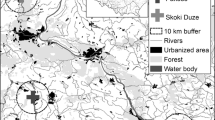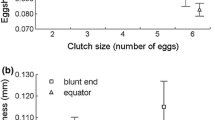Abstract
Maintaining eggshell thickness is critical for birds, as thin eggshells result in breakage during incubation, with subsequent hatching failure. Beginning in the 1960s, eggshell thickness has been used as a biomarker of exposure to chlorinated hydrocarbon pesticides, as a measure of avian population health, and as a predictor of potential reproductive failures. In this study, eggs were collected from four coastal bird species nesting in the New York Bight (Cedar Beach, NY to Barnegat Bay, NJ) in the early 1970s, early 1980s, and early 1990s, and eggshell thickness was measured. We tested the hypothesis that decreasing use of chlorinated hydrocarbons, and subsequent decreased levels of these pollutants in the New York Bight estuarine food web, should have resulted in increased eggshell thickness from the 1970s to the 1990s. Most of the variation in eggshell thickness was explained by decade and species. Eggshell thickness increased from the early 1970s (or the 1980s for some species) to the early 1990s for all four species examined: common tern (Sterna hirundo), Roseate tern (S. dougallii), least tern (S. antillarum), and black skimmer (Rynchops niger). For common terns and black skimmers, eggshell thickness increased by nearly 50% from the 1970s to the 1990s, whereas in the smallest species, the least tern, eggshell thickness increased only by 12%. In the 1990s, least terns with the smallest eggs had the thinnest eggshells, and black skimmers with larger eggs had the thickest eggshells.
Similar content being viewed by others
References
Anderson DW, Hickey JJ (1972) Eggshell changes in certain North American birds. Proc XV Int Ornithol Congr 514–540
Bunck CM, Spann JW, Pattee OH, Fleming WJ (1985) Changes in eggshell thickness during incubation: Implications for evaluating the impact of organochlorine contaminants on productivity. Bull Environ Contam Toxicol 35:173–182
Burger J (1994a) Metals in avian feathers: Bioindicators of environmental pollution. Rev Environ Toxicol 5:203–311
Burger J (1994b) Heavy metals in avian eggshells: Another excretion method. J Toxicol Environ Health 41:207–220
Burger J, Gochfeld (1990) The black skimmer: Social dynamics of a colonial species. Columbia Univ Press, NY
Burger J (1991) The common tern: Its breeding biology and social behavior. Columbia Univ Press, NY
Findholt SL, Trost CH (1985) Organochlorine pollutants, eggshell thickness, and reproductive success of black-crowned night-herons in Idaho, 1979. Colonial Waterbirds 8:32–41
Fleming WJ, Rodgers JA Jr, Stafford CJ (1984) Contaminants in wood stork eggs and their effects on reproduction, Florida, 1982. Colonial Waterbirds 7:88–93
Forsyth DJ, Martin PA, DeSmet KD, Riske ME (1994) Organochlorine contaminants and eggshell thinning in grebes from prairie Canada. Environ Pollut 85:51–58
Fox GA (1974). Eggshell quality and DDE: Correlation with reproductive success in the common tern. Master's Thesis, University of Alberta, Edmonton, Canada
Frenzel RW, Anthony RG (1989) Relationship of diets and environmental contaminants in wintering bald eagles. J Wildl Manage 53:792–802
Fyfe RW, Risebrough RW, Mond JG, Marman WM, Anderson DW, Kiff LF, Lincer JL, Nisbet ICT, Walker WH, Walton BJ (1988) DDE, productivity, and eggshell thickness relationships in the genus Falco. In: Cade TJ, Enderson JG, Thelander CG, White CM (eds) Peregrine falcon populations: Their management and recovery. The Peregrine Fund, Inc., Boise, ID, pp 319–335
Gochfeld M (1975) Developmental defects in common terns of Western Long Island, New York. Auk 92:58–65
Grubb TG, Wiemeyer SN, Kiff LF (1990) Eggshell thinning and contaminant levels in bald eagle eggs from Arizona, 1977–1985. Southwestern Nat 35:298–301
Hamilton RMG, Hollands KG, Voisey PW, Grunder AA (1979) Relationship between egg shell quality and shell breakage and factors that affect shell breakage in the field—A review. World's Poultry Sci J 35:177–190
Hays H, Risebrough RW (1972) Pollutant concentration in abnormal young ferns from Long Island sound. Auk 89:19–35
Hickey JJ (1969) The peregrine falcon populations: Their biology and decline. Univ Wisc Press, Madison, WI
Hickey JJ, Anderson DW (1968) Chlorinated hydrocarbons and eggshell changes in raptorial and fish-eating birds. Science 162:271–273
Kozie KD, Anderson RK (1991) Productivity, diet, and environmental contaminants in bald eagles nesting near the Wisconsin shoreline of Lake Superior. Arch Environ Contam Toxicol 20:41–48.
Lincer JL (1975) DDE-induced eggshell thinning in the American kestrel: A comparison of the field situation and laboratory results. J Appl Ecol 12:781–793
Lindvall ML, Low JB (1980) Effects of DDE, TDE, and PCBs on shell thickness of western grebe eggs, Bear River Migratory Bird Refuge, Utah, 1973–1974. Pest Monit J 14:108–111
Longcore JR, Samson FB, Whittendale TW Jr (1971) DDE thins eggshells and lowers reproductive success of captive black ducks. Bull Environ Contam Toxicol 6:485–490
McLane MAR, Hall LC (1972) DDE thins Screech Owl eggshells. Bull Environ Contam Toxicol 8:65–68
Moser FC (1990) Toxic levels in water, sediment and biota, and their effects in the Hudson-Raritan Estuary, Long Island Sound and the New York Bight. In: Bricke K, Thomann RV (eds) Cleaning up our coastal waters: An unfinished agenda. Dynamac Corp, Riverdale, NY, pp 355–380
Mueller JA (1990) Toxic inputs and fate in the New York-New Jersey harbor, Bight, and Long Island Sound. In: Bricke K, Thomann RV (eds) Cleaning up our coastal waters: An unfinished agenda. Dynamac Corp, Riverdale, NY, pp 317–354
Ohlendorf HM, Klaas EE, Kaiser TE (1979) Environmental pollutants and eggshell thickness: Anhingas and wading birds in the eastern United States. U. S. Fish & Wildlife Service Spec. Scient Rep Wildlife No. 216:1–94
Peakall DB (1975) Physiological effects of chlorinated hydrocarbons on avian species. In: Hague R, Freed VH (eds) Environmental dynamics of pesticides. Plenum Press, NY, pp 343–360
Peakall DB, Lincer JL, Risebrough RW, Pritchard JB, Kinter WB (1973) DDE-induced egg-shell thinning: Structural and physiological effects in three species. Comp Gen Pharmac 4:305–313
Ratcliffe DA (1970) Changes attributable to pesticides in egg breakage frequency and eggshell thickness in some British birds. J Appl Ecol 7:67–116
Safina C, Burger J (1988) Prey dynamics and the breeding phenology common terns Auk 105:720–726
SAS (1985) Users guide: Statistics. SAS Institute, Inc., Cary, NC
Squibb KS, O'Connor J, Kneip TJ (1991) New York/New Jersey harbor estuary program: Toxics characterization report. EPA, NY
Switzer B, Lewin V, Wolfe FH (1971). Shell thickness, DDE levels in eggs, and reproductive success in common terns (Sterna hirundo) in Alberta. Can J Zool 49:69–73
Tejning S (1967) Biological effects of methymercury dicyandiamide-treated grain in the domestic fowl Gallus gallus L. Oikos Suppl 8:1–116
Wiemeyer SN, Porter RD (1970) DDE thins eggshells of captive American kestrels. Nature 227:737–738
Wiemeyer SN, Bunck CM, Krynitsky AJ (1988) Organochlorine pesticides, polychlorinated biphenyls, and mercury in osprey eggs—1970–1979—and their relationships to shell thinning and productivity. Arch Environ Contam Toxicol 17:767–787
Wiemeyer SN, Bunck CM, Stafford CJ (1993) Environmental contaminants in bald eagle eggs—1980–84—and further interpretations of relationships to productivity and shell thickness. Arch Environ Contam Toxicol 24:213–227
Young DR (1982) Chlorinated hydrocarbon contaminants in the Southern California and New York Bight. In: Mayer GF (ed) Ecological stress and the New York Bight: Science and management. Estuarine Research Found, Columbus, SC, pp 263–276
Author information
Authors and Affiliations
Rights and permissions
About this article
Cite this article
Burger, J., Viscido, K. & Gochfeld, M. Eggshell thickness in marine birds in the New York Bight—1970s to 1990s. Arch. Environ. Contam. Toxicol. 29, 187–191 (1995). https://doi.org/10.1007/BF00212969
Received:
Revised:
Issue Date:
DOI: https://doi.org/10.1007/BF00212969




